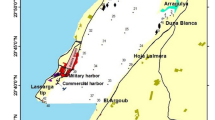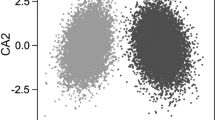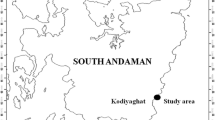Synopsis
The fish assemblage in nineteen shallow water (0–3 m) areas on the Swedish west coast, including an estuarine zone, was assessed during spring and autumn 1989 and autumn 1990, using semi-quantitative survey nets. Samples of macrovegetation were collected concurrently for estimates of species composition and biomass. Nine stations had rocky-bottom substrata and ten had soft-bottom substrata all characterized by high coverage of macrovegetation and variously overgrown with epiphytic filamentous algae. Fish assemblage structures were compared and related to vegetation biomass, substrata and estuarine influences. At rocky-bottom stations total fish biomass was positively correlated with total vegetation biomass and negatively correlated with the proportion of filamentous algae during autumn samplings. In soft-bottom habitats variation in vegetation was small between stations, and no correlation existed between vegetation biomass and fish biomass. However, the number of fish species in soft-bottom habitats decreased significantly with increasing dominance of filamentous algae. The component species of the fish assemblage varied in their relation to the vegetation biomass and structure suggesting differences in degree of association with vegetation at the species level. Multivariate analysis based on fish species composition and on vegetation assemblages at the individual stations, yielded two major groups in accordance with division of the substrate into rocky- and soft-bottom habitats. Vegetation biomass superimposed on the fish assemblage ordination indicated a relationship between vegetation biomass and fish assemblage structure. Location of stations, in relation to the estuary was reflected in subgroups formed in the fish assemblage based cluster and ordination, suggesting a substantial estuarine influence on the fish assemblages. Thus, substrate type, vegetation biomass and structure, and estuarine influence are all potential structuring factors for the fish assemblages. In our study, vegetation structure seems to be of major importance and changes such as increased dominance of filamentous algae, like that observed in coastal areas in Sweden, might cause significant changes in fish assemblage structure.
Similar content being viewed by others
References cited
Adams, S.M. 1976. The ecology of eelgrass,Zostera marina (L.) fish communities. I. Structural analysis. J. Exp. Mar. Biol. Ecol. 22: 269–291.
Allen, L.G. 1985. A habitat analysis of the nearshore marine fishes from southern California. Bull. South. Calif. Acad. Sci. 84: 133–155.
Aneer, G., G. Florell, U. Kautsky, S. Nellbring & L. Sjöstedt. 1983. In-situ observation of Baltic herring (Clupea harengus membras) spawning behaviour in the Askö-Landsort area, northern Baltic proper. Mar. Biol. 74: 105–110.
Baden, S. & L. Pihl. 1984. Abundance, biomass and production of mobile epibenthic fauna inZostera marina (L.) meadows, western Sweden. Ophelia 23: 65–90.
Bell, J.D., A.S. Steffe & M. Westoby. 1988. Location of seagrass beds in estuaries: effects on associated fish and decapods. J. Exp. Mar. Biol. Ecol. 122: 127–146.
Blaber, S.J.M. & T.G. Blaber. 1980. Factors affecting the distribution of juvenile estuarine and inshore fish. J. Fish Biol. 17: 143–162.
Blomqvist, E.M. 1984. Changes in fish community structure and migration activity in a brackish bay isolated by land upheaval and reverted by dredging. Ophelia Suppl. 3: 11–21.
Borum, J. 1985. Development of epiphytic communities on eelgrass (Zostera marina) along a nutrient gradient in a Danish estuary. Mar. Biol. 87: 211–218.
Breuer G. & W. Schramm. 1988. Changes in macroalgal vegetation of Kiel Bight (western Baltic Sea) during the past 20 years. Kieler Meeresforsch. 6: 241–255.
Choat, J.H. & A.M. Ayling. 1987. The relationship between habitat structure and fish faunas on New Zealand reefs. J. Exp. Mar. Biol. Ecol. 110: 257–284.
Clarke, K.R. & R.H. Green. 1988. Statistical design and analysis for a ‘biological effects’ study. Mar. Ecol. Prog. Ser. 46: 213–226.
Curry-Lindahl, K. 1985. Vara Fiskar: Havs-och sötvattenfiskar i Norden och övriga Europa (Marine and fresh-water fishes in Scandinavia and northern Europe). P.A. Nordsteds & Söners Förlag, Stockholm. 528 pp.
DeMartini, E.E. & D.A. Roberts. 1990. Effects of giant kelp (Macrocystis) on the density and abundance of fishes in a cobble-bottom kelp forest. Bull. Mar. Sci. 46: 287–300.
Elliott, M., M.G. O'Reilly & C.J.L. Taylor. 1990. The Forth Estuary: a nursery and overwintering area for the North Sea fishes. Hydrobiol. 195: 89–103.
Evans, S. & B. Tallmark. 1979. A modified drop-net method for sampling mobile epifauna on marine shallow sandy bottoms. Holarct. Ecol. 2: 58–64.
Field, J.G., K.R. Clarke & R.M. Warwick. 1982. A practical strategy for analysing multispecies distribution patterns. Mar. Ecol. Prog. Ser. 8: 37–52.
Fossa, J.H. 1989. A drop-net method for samplingGobiusculus flavescens (Fabricius) and other fishes on hard and mixed bottoms with algal cover. Sarsia 74: 107–113.
Gibson, R.N. 1967. The use of anesthetic quinaldine in fish ecology. J. Anim. Ecol. 36: 295–301.
Gibson, R.N. 1982. Recent studies on the biology of intertidal fishes. Oceanogr. Mar. Biol. Ann. Rev. 20: 363–414.
Hull, S.C. 1987. Macroalgal mats and species abundance: a field experiment. Estuar. Coast. Shelf Sci. 25: 519–532.
Humphries, P., I.C. Potter & N.R. Loneragan. 1992. The fish community in the shallows of a temperate Australian estuary: relationships with the aquatic marcophyteRuppia megacarpa and environmental variables. Estuar. Coast. Shelf Sci. 34: 325–346.
Isaksson, I. & L. Pihl. 1992. Structural changes in benthic macrovegetation and associated epibenthic faunal communities. Neth. J. Sea Res. 30: 131–140.
Jansson, B.O., G. Aneer & S. Nellbring. 1985. Spatial and temporal distribution of the demersal fish fauna in a Baltic archipelago as estimated by SCUBA census. Mar. Ecol. Prog. Ser. 23: 31–43.
Kautsky, N., H. Kautsky, U. Kautsky & M. Waern. 1986. Decreased depth penetration ofFucus vesiculosus (L.) since the 1940's indicates eutrophication of the Baltic Sea. Mar. Ecol. Prog. Ser. 28: 1–8.
Keats, D.W., D.H. Steele & G.R. South. 1987. The role of fleshy macroalgae in the ecology of juvenile cod (Gadus morhua L.) in inshore waters off eastern Newfoundland. Can. J. Zool. 65: 49–53.
Lavery, P.S., R.J. Lukatelich & A.J. McComb. 1991. Changes in the biomass and species composition of macroalgae in a eutrophic estuary. Estuar. Coast. Shelf Sci. 33: 1–22.
Lenanton, R.C.J. & N. Caputi. 1989. The roles of food supply and shelter in the relationship between fishes, in particularCnidoglanis macrocephalus (Valenciennes), and detached macrophytes in the surf zone of sandy beaches. J. Exp. Mar. Biol. Ecol. 128: 165–176.
Lindgren, P.E. 1965. Coastal algae off Göteborg in relation to gradients in salinity and pollution. Acta Phytogeogr. Suec. 50: 92–96.
Loneragan, N.R. & I.C. Potter. 1990. Factors influencing community structure and distribution of different life-cycle categories of fishes in shallow waters of a large Australian estuary. Mar. Biol. 106: 25–37.
Lubbers, L., W.R. Boynton & W.M. Kemp. 1990. Variations in structure of estuarine fish communities in relation to abundance of submersed vascular plants. Mar. Ecol. Prog. Ser. 65: 1–14.
Mattila, J. & E. Bonsdorff. 1988. A quantitative estimation of fish predation on shallow soft bottom benthos in SW Finland. Kieler Meeresforsch., Sonderh. 6: 111–125.
Munda, I.M. 1978. Salinity dependent distribution of benthic algae in estuarine areas of Icelandic fjords. Bot. Mar. 21: 451–468.
Muus, B.J. 1967. The fauna of Danish estuaries and lagoons. Distribution and ecology of dominating species in the shallow reaches of the mesohaline zone. Meddr. Damn. Fisk-og Havunders. N.S. 5: 7–316.
Nash, R.D.M. 1988. The effects of disturbance and severe seasonal fluctuations in environmental conditions on north temperate shallow-water fish assemblages. Estuar. Coast. Shelf Sci. 26: 123–135.
Orth, R.J., I.K.L. Heck, Jr. & J. van Montfrans. 1984. Faunal communities in seagrass beds: a review of the influence of plant structure and prey characteristics on predator-prey relationships. Estuaries 7: 339–350.
Pihl, L. 1982. Food intake of young cod and flounder in a shallow bay on the Swedish west coast. Neth. J. Sea Res. 15: 419–432.
Pihl, L. & R. Rosenberg. 1982. Production, abundance, and biomass of mobile epibenthic marine fauna in shallow waters, western Sweden. J. Exp. Mar. Biol. Ecol. 57: 273–301.
Raffaelli, D., S. Hull & H. Milne. 1989. Long-term changes in nutrients, weed mats and shorebirds in an estuarine system. Cah. Biol. Mar. 30: 259–270.
Raffaelli, D., J. Limia, S. Hull & S. Pont. 1991. Interactions between the amphipodCorophium volutator and macroalgal mats on estuarine mudflats. J. Mar. Biol. Ass. U.K. 71: 899–908.
Riley, J.D., D.J. Symonds & L. Woolner. 1981. On the factors influencing the distribution of 0-group demersal fish in coastal waters. Rapp. P-v. Réun. Cons. Int. Explor. Mer. 178: 223–228.
Rozas, L.P. & W.E. Odum. 1988. Occupation of submerged aquatic vegetation by fishes: testing the roles of food and refuge. Oecologia 77: 101–106.
Sale, P.F. 1980. The ecology of fishes on coral reefs. Oceanogr. Mar. Biol. Ann. Rev. 18: 367–421.
Selmer, J.-S. & L. Rydberg. 1993. Effects of nutrient discharge by river water and waste water on the nitrogen dynamics in the archipelago of Göteborg, Sweden. Mar. Ecol. Prog. Ser. 92: 119–133.
Sogard, S.M. & K.W. Able. 1991. A comparison of eelgrass, sea lettuce macroalgae and marsh creeks as habitats for epibenthic fishes and decapods. Est. Coast. Shelf Sci. 33: 501–519.
Svane, I. & F. Gröndahl. 1989. Epibioses of Gullmarsfjorden: an underwater stereophotographical transect analysis in comparison with the investigations of Gislén in 1926–29. Ophelia 28: 95–110.
Thorman, S. & A.-M. Wiederholm. 1986. Food, habitat and time niches in a coastal fish species assemblage in a brackish water bay in the Bothnian Sea, Sweden. J. Exp. Mar. Biol. Ecol. 95: 57–86.
Wallentinus, I. 1984. Comparisons of nutrient uptake rates for Baltic macroalgae with different thallus morphologies. Mar. Biol. 80: 215–225.
Wheeler, A. 1980. Fish-algal relations in temperate waters. pp. 677–698.In: J.H. Price, D.E.G. Irvine & W.F. Farnham (ed.) The Shore Environment, Academic Press, London.
Worthington, D.G., M. Westoby & J.D. Bell. 1991. Fish larvae settling in seagrass: effects of leaf density and an epiphytic alga. Aust. J. Ecol. 16: 289–293.
Zijlstra, J.J. 1972. On the importance of the Wadden Sea as a nursery area in relation to the observation of the southern North Sea fishery resources. Symp. Zool. Soc. Lond. 29: 233–258.
Author information
Authors and Affiliations
Rights and permissions
About this article
Cite this article
Pihl, L., Wennhage, H. & Nilsson, S. Fish assemblage structure in relation to macrophytes and filamentous epiphytes in shallow non-tidal rocky- and soft-bottom habitats. Environ Biol Fish 39, 271–288 (1994). https://doi.org/10.1007/BF00005129
Received:
Accepted:
Issue Date:
DOI: https://doi.org/10.1007/BF00005129




